AZ-204: Developing Solutions for Microsoft Azure
Exploring Azure Event Hubs
Exploring Event Hubs Capture
Azure Event Hubs Capture is a powerful feature that automatically streams incoming data from Event Hubs into your Azure storage accounts, such as Blob Storage or Data Lake Storage. This functionality is crucial for building both real-time and batch-based data pipelines, allowing for seamless live data analysis and efficient archival for future processing.
By automating data ingestion, Event Hubs Capture simplifies the process of dealing with high-volume event streams, ensuring cost-effective storage and streamlined analysis without the need for complex custom solutions. In this guide, we'll walk through the core features of Event Hubs Capture, its windowing and scaling mechanisms, and how to set it up and verify its output using the Azure Portal.
How Capture Works: Windowing
Event Hubs Capture enables you to configure specific time or size windows for data capture. Each partition in the Event Hub writes its data independently; at the end of each capture window, the accumulated data is written to storage as a blob. The blob naming convention reflects the exact time of capture, making it simple to track data processing intervals.

The diagram below outlines the capture window setup, highlighting three crucial points:
- Configurable windows control the capture process.
- Each partition captures data independently.
- Blobs are created after each capture interval, with names indicating the precise capture time.

Scaling with Throughput Units
Event Hubs Capture leverages throughput units (TUs) to manage event hub traffic and automatically scales to meet demand. A noteworthy benefit is that the capture process operates independently of throughput unit quotas, ensuring it does not affect your processing egress limits even during peak data flows.
Automatic Capture Trigger
Event Hubs Capture begins as soon as the first event is sent, eliminating the need for any manual intervention.
This design guarantees smooth data ingestion and consistent storage performance under various load conditions, making it ideal for both high-volume environments and batch processing tasks.
Setting Up Azure Event Hubs Capture
Now let's explore how to configure an Event Hub in the Azure Portal with Capture enabled.
Upgrade Your Event Hub Tier
In the Azure Portal, ensure your Event Hub is upgraded to the Standard tier, which provides access to the capture feature (the Basic tier does not support this). Once upgraded, navigate to your Event Hubs namespace.Create an Event Hub
Follow these steps to create your Event Hub:- Name it "Hub 01".
- Set the partition count to one.
- Configure the cleanup policy as "Delete" with a retention period of one hour.
- Enable Capture and specify your desired capture window settings (for example, a five-minute window, or a smaller size window such as 10 MB and one minute for demonstration).
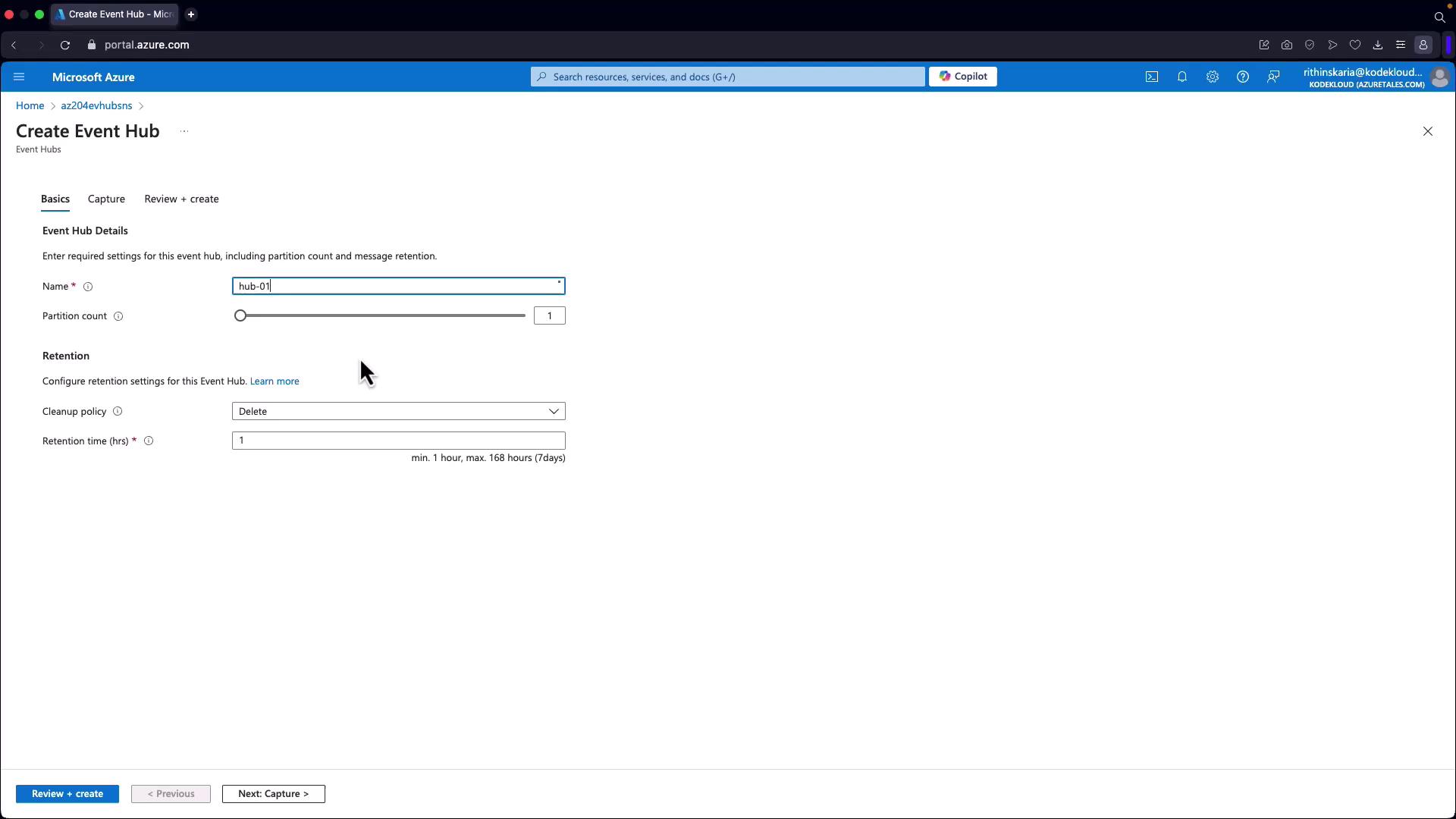
Configure Capture Settings
In the Capture settings, click on "Select Container" to configure the storage account or ADLS container. You can modify the container name if necessary. The default blob naming format includes details such as namespace, Event Hub, partition ID, and a timestamp (year, month, day, hour, minute, and second). Choose your preferred authentication method; for this example, Shared Access Signatures (SAS) are used, though Managed Identities are also an option.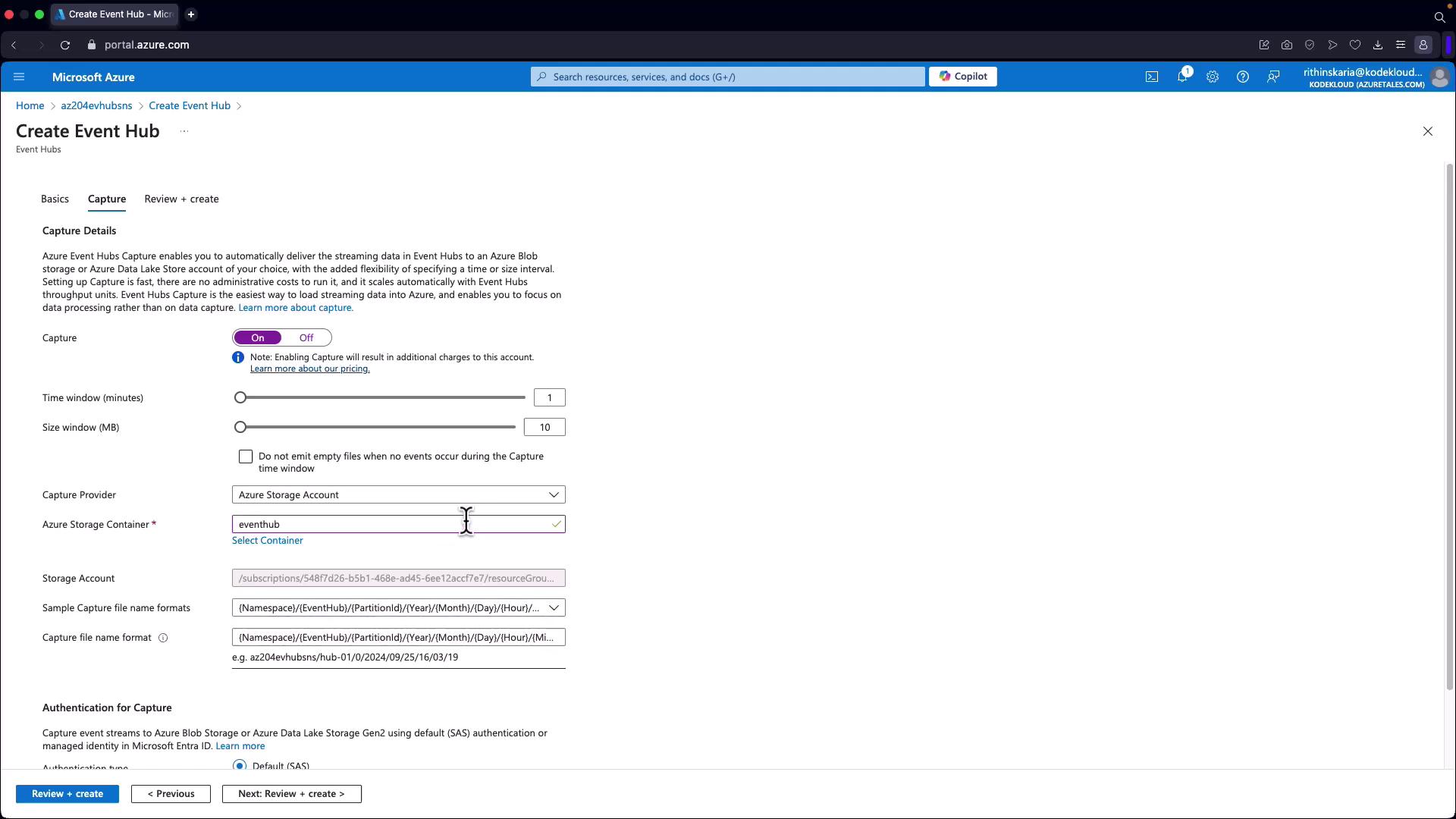
Generate Events for Testing
After creating the Event Hub, generate some events to test your configuration.
Generating and Streaming Events
There are several methods to generate events. One option is to use the .NET SDK (a topic for another guide). In this instance, you'll configure diagnostic settings on an Azure App Service (e.g., "Flight Logs") to generate events:
Configure Diagnostic Settings for an App Service
- Navigate to your App Service.
- Expand "Diagnostic Settings" and configure it to capture logs and metrics.
- Provide a name for the log stream (e.g., "app logs EVH").
- Select "Hub01" as the destination using the root managed shared access key.
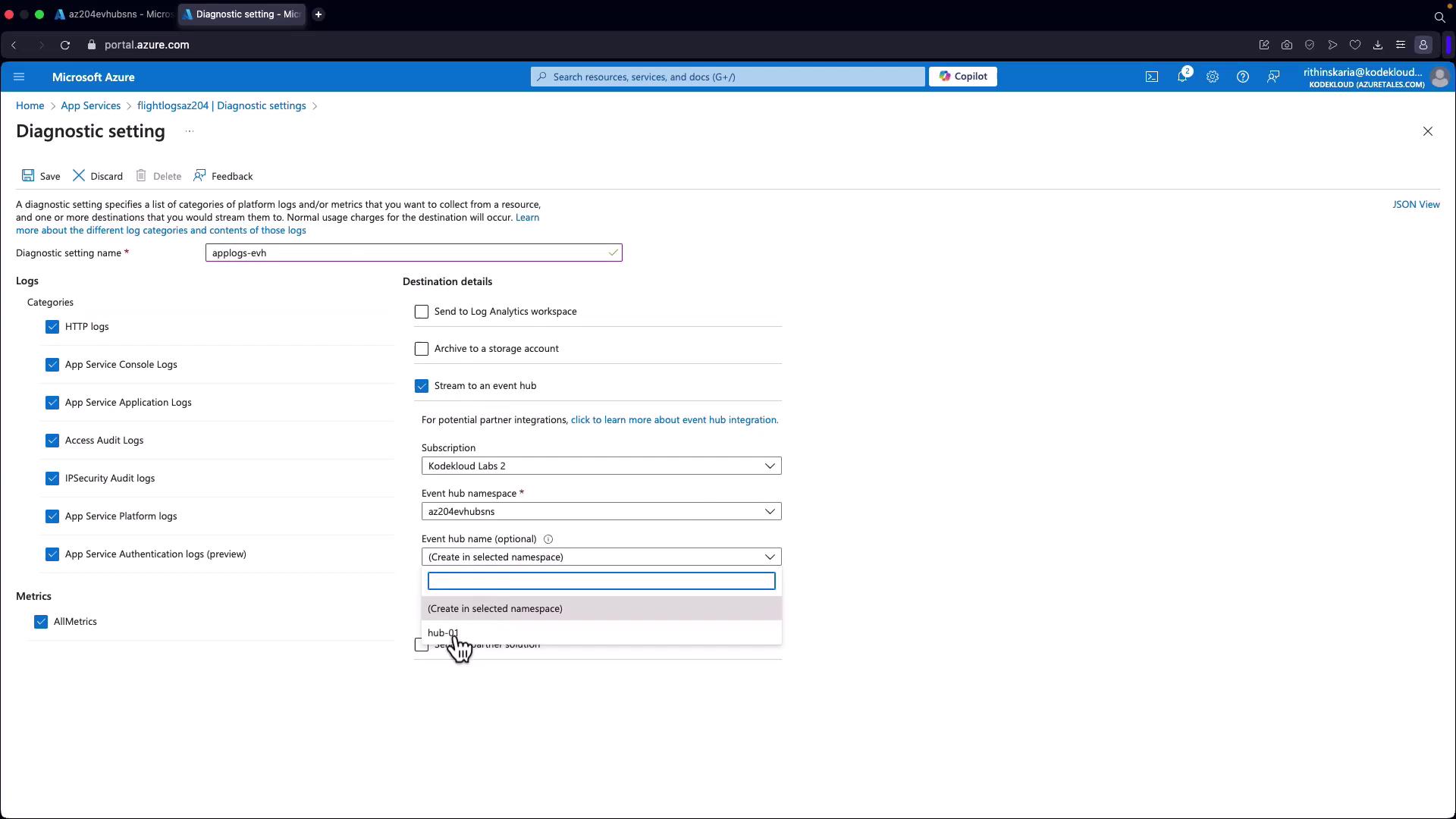
Save and Stream Logs
Once saved, all App Service requests and audit logs are streamed to your Event Hub.View the Captured Events
To review the events:- Navigate to the "View Events" section in the Event Hub's Data Explorer.
- You will observe incoming events, including API requests and logs from your App Service.

Below are sample events captured from the Flight Logs:
Sample Python Event
A sample event captured in Python format:
{
'records': [
{
'time': '2024-09-25T16:06:06.64683232Z',
'resourceId': '/SUBSCRIPTIONS/54B7D26-B5B1-468E-AD45-6E21EACF7E7/RESOURCEGROUPS/RG-AZ204-APIM/PROVIDERS/MICROSOFT.WEB/SITES/FLIGHTLOGSAZ204',
'category': 'AppServiceApplogs',
'operationName': 'Microsoft.Web/sites/log',
'level': 'Information',
'resultDescription': 'Application started. Press Ctrl+c to shut down..',
'properties': {
'preciseDateTime': '2024-09-25T16:06:06.64349200Z',
'resource': 'flightlogsa224.azurewebsites.net',
'source': 'Microsoft.Diagnostics.Tracing.ENTraceEventSource',
'websiteInstanceId': 'null',
'level': 'Information',
'message': 'Application started. Press Ctrl+c to shut down..',
'stackTrace': 'null'
}
}
]
}
Another example in JSON format demonstrating multiple App Service logs:
{
"records": [
{
"time": "2024-09-25T16:06:06.684521Z",
"resourceId": "/SUBSCRIPTIONS/5487D26-B51D-46BE-AD45-6E12ACCF7E7/RESOURCEGROUPS/RG-AZ204-APIM/PROVIDERS/MICROSOFT.WEB/SITES/FLIGHTLOGSAZ204",
"category": "AppServiceAppLogs",
"operationName": "Microsoft.Web/sites/log",
"level": "Information",
"resultDescription": "Hosting environment: Production",
"properties": {
"preciseDateTime": "2024-09-25T16:06:03.0637930+00:00",
"resourceId": "flightlogsa204.azurewebsites.net",
"source": "Microsoft.Diagnostics.Tracing.ETWTraceEventSource",
"webSiteInstanceId": "",
"level": "Information",
"message": "Hosting environment: Production",
"stacktrace": null
}
},
{
"time": "2024-09-25T16:06:06.684563Z",
"resourceId": "/SUBSCRIPTIONS/5487D26-B51D-46BE-AD45-6E12ACCF7E7/RESOURCEGROUPS/RG-AZ204-APIM/PROVIDERS/MICROSOFT.WEB/SITES/FLIGHTLOGSAZ204",
"category": "AppServiceAppLogs",
"operationName": "Microsoft.Web/sites/log",
"level": "Information",
"resultDescription": "Content root path: C:\\home\\site\\wwwroot",
"properties": {
"preciseDateTime": "2024-09-25T16:06:03.0644247+00:00",
"resourceId": "flightlogsa204.azurewebsites.net",
"source": "Microsoft.Diagnostics.Tracing.ETWTraceEventSource",
"webSiteInstanceId": "",
"level": "Information",
"message": "Content root path: C:\\home\\site\\wwwroot",
"stacktrace": null
}
},
{
"time": "2024-09-25T16:06:06.684574Z",
"resourceId": "/SUBSCRIPTIONS/5487D26-B51D-46BE-AD45-6E12ACCF7E7/RESOURCEGROUPS/RG-AZ204-APIM/PROVIDERS/MICROSOFT.WEB/SITES/FLIGHTLOGSAZ204",
"category": "AppServiceAppLogs",
"operationName": "Microsoft.Web/sites/log",
"level": "Information",
"resultDescription": "Application is shutting down...",
"properties": {
"preciseDateTime": "2024-09-25T16:06:03.0649820+00:00",
"resourceId": "flightlogsa204.azurewebsites.net",
"source": "Microsoft.Diagnostics.Tracing.ETWTraceEventSource",
"webSiteInstanceId": "",
"level": "Information",
"message": "Application is shutting down...",
"stacktrace": null
}
}
]
}
These examples demonstrate how multiple records can be captured together, highlighting the batch processing capabilities of Event Hubs Capture. For improved readability during debugging, consider copying the output into an editor like Visual Studio Code.
Verifying Capture Output in Storage
To verify that events are captured correctly, follow these steps:
Access the Storage Account
Navigate to the Azure Portal and open your configured storage account. Under the "Containers" section, select the container associated with your Event Hub.Review the Capture Folders
You will see folders generated based on the capture window configuration, typically named with timestamps. For example, you might see a folder labeled with a timestamp like "0-20-24, September 25th, four." Opening this folder will reveal an AVRO file containing your event records.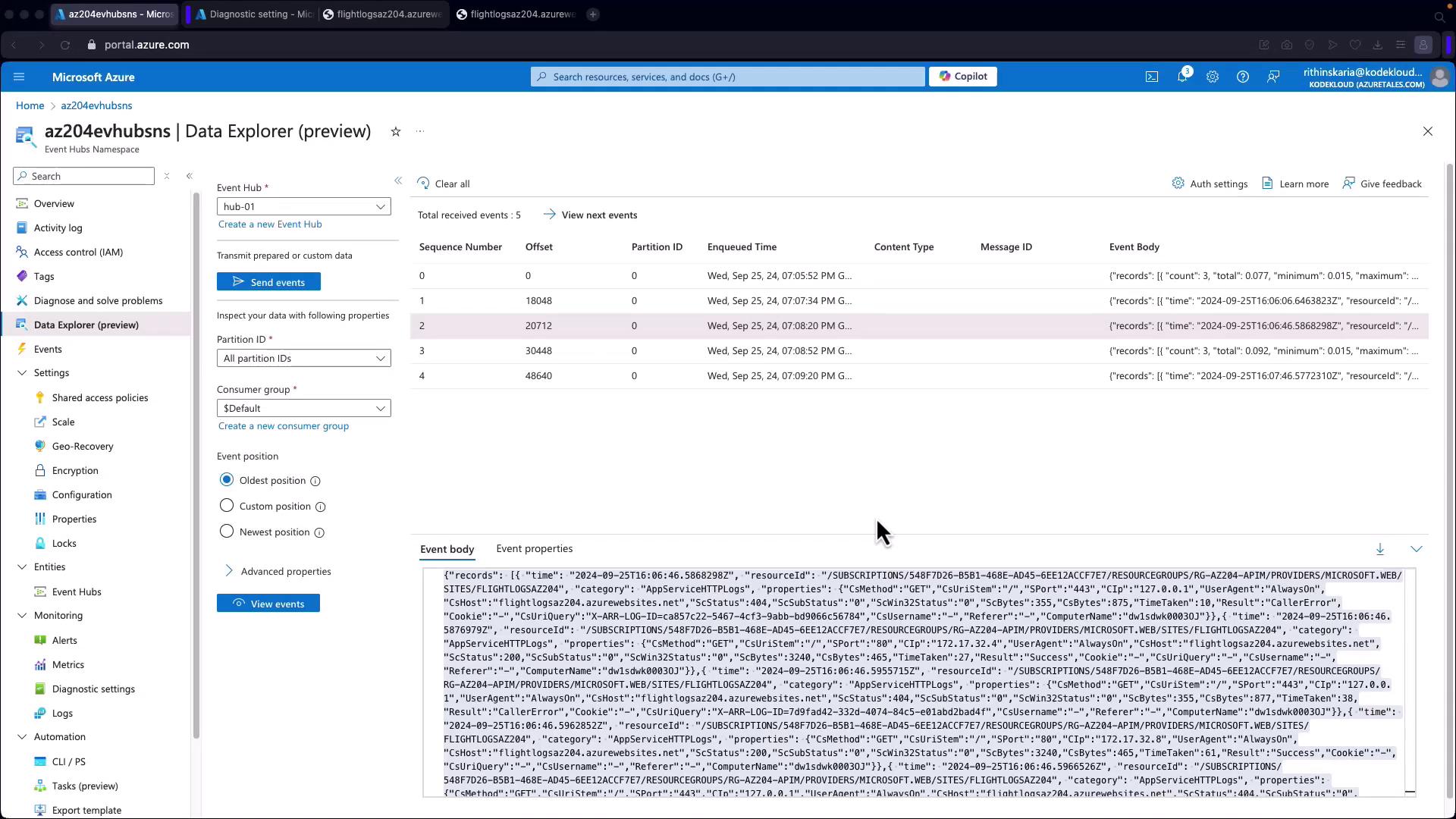
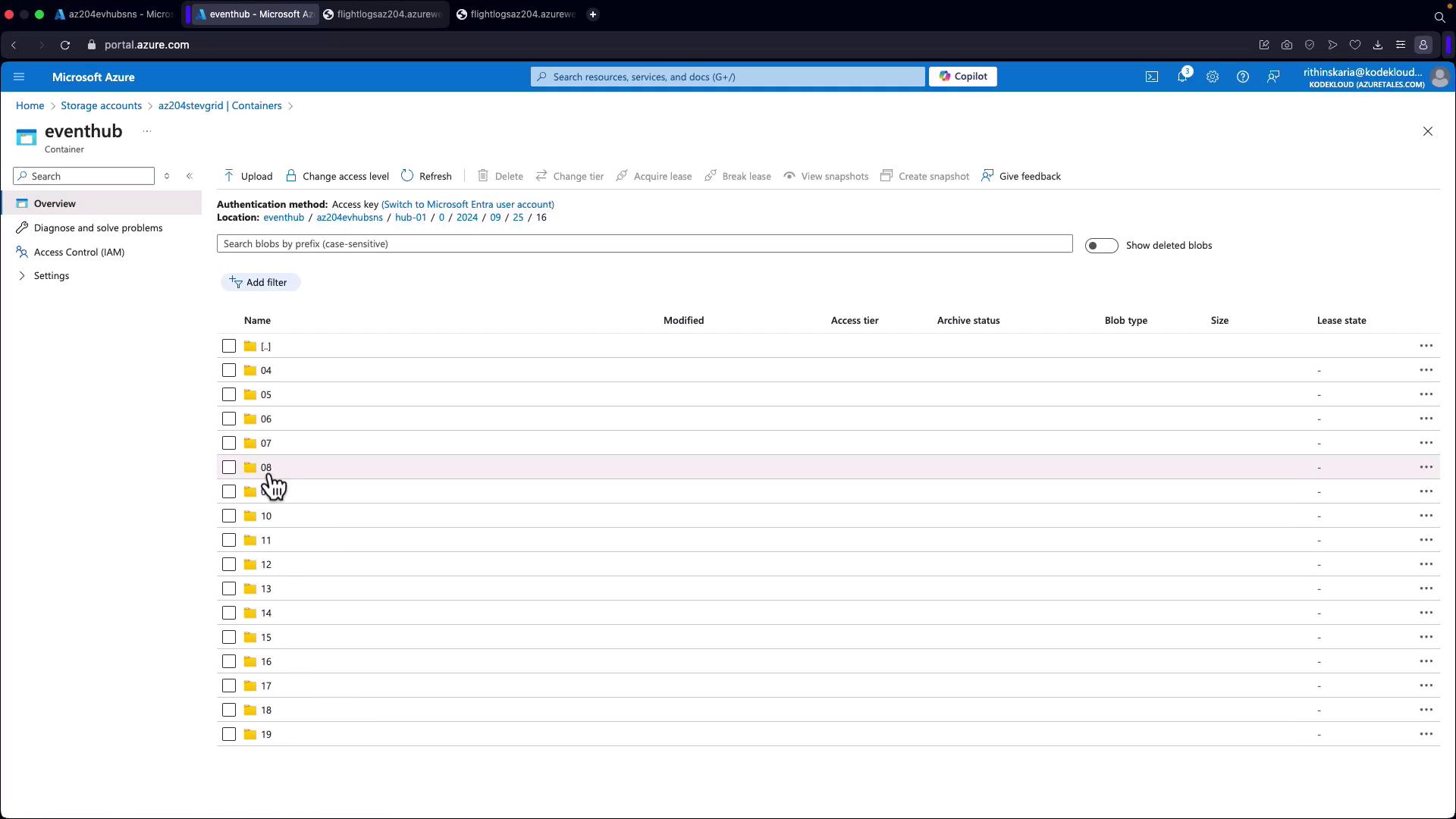
Capture Window Adjustment
Remember, adjusting the capture window size will influence the number of files generated. A smaller window will result in more files, making it useful for demonstration purposes.
Conclusion
In this guide, you've learned how Azure Event Hubs Capture seamlessly streams and stores event data, the advantages of its windowing and throughput mechanisms, and the steps required to set it up using the Azure Portal. This robust and scalable feature ensures that your event-driven applications can efficiently process data in near real-time, whether for live analysis or batch processing.
By integrating Event Hubs Capture into your solution, you can ensure reliable and efficient data ingestion that scales with your application's needs.
For additional resources, consider exploring the following:
Happy streaming!
Watch Video
Watch video content